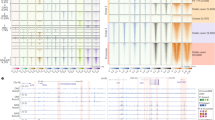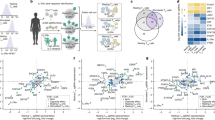Abstract
The transcription factor Foxp3 participates dominantly in the specification and function of Foxp3+CD4+ regulatory T cells (Treg cells) but is neither strictly necessary nor sufficient to determine the characteristic Treg cell signature. Here we used computational network inference and experimental testing to assess the contribution of other transcription factors to this. Enforced expression of Helios or Xbp1 elicited distinct signatures, but Eos, IRF4, Satb1, Lef1 and GATA-1 elicited exactly the same outcome, acting in synergy with Foxp3 to activate expression of most of the Treg cell signature, including key transcription factors, and enhancing occupancy by Foxp3 at its genomic targets. Conversely, the Treg cell signature was robust after inactivation of any single cofactor. A redundant genetic switch thus 'locked in' the Treg cell phenotype, a model that would account for several aspects of Treg cell physiology, differentiation and stability.
This is a preview of subscription content, access via your institution
Access options
Subscribe to this journal
Receive 12 print issues and online access
$209.00 per year
only $17.42 per issue
Buy this article
- Purchase on SpringerLink
- Instant access to full article PDF
Prices may be subject to local taxes which are calculated during checkout






Similar content being viewed by others
References
Sakaguchi, S., Yamaguchi, T., Nomura, T. & Ono, M. Regulatory T cells and immune tolerance. Cell 133, 775–787 (2008).
Feuerer, M. et al. Lean, but not obese, fat is enriched for a unique population of regulatory T cells that affect metabolic parameters. Nat. Med. 15, 930–939 (2009).
Josefowicz, S.Z., Lu, L.F., Rudensky, A.Y. & Regulatory, T. Cells: Mechanisms of differentiation and function. Annu. Rev. Immunol. 30, 531–564 (2012).
Curotto de Lafaille, M.A. & Lafaille, J.J. Natural and adaptive foxp3+ regulatory T cells: more of the same or a division of labor? Immunity 30, 626–635 (2009).
Duarte, J.H. et al. Natural Treg cells spontaneously differentiate into pathogenic helper cells in lymphopenic conditions. Eur. J. Immunol. 39, 948–955 (2009).
Tsuji, M. et al. Preferential generation of follicular B helper T cells from Foxp3+ T cells in gut Peyer's patches. Science 323, 1488–1492 (2009).
Murai, M. et al. Interleukin 10 acts on regulatory T cells to maintain expression of the transcription factor Foxp3 and suppressive function in mice with colitis. Nat. Immunol. 10, 1178–1184 (2009).
Zhou, X. et al. Instability of the transcription factor Foxp3 leads to the generation of pathogenic memory T cells in vivo. Nat. Immunol. 10, 1000–1007 (2009).
Rubtsov, Y.P. et al. Stability of the regulatory T cell lineage in vivo. Science 329, 1667–1671 (2010).
Komatsu, N. et al. Heterogeneity of natural Foxp3+ T cells: a committed regulatory T-cell lineage and an uncommitted minor population retaining plasticity. Proc. Natl. Acad. Sci. USA 106, 1903–1908 (2009).
Hill, J.A. et al. Foxp3 transcription-factor-dependent and -independent regulation of the regulatory T cell transcriptional signature. Immunity 27, 786–800 (2007).
Feuerer, M., Hill, J.A., Mathis, D. & Benoist, C. Foxp3+ regulatory T cells: differentiation, specification, subphenotypes. Nat. Immunol. 10, 689–695 (2009).
Vignali, D.A., Collison, L.W. & Workman, C.J. How regulatory T cells work. Nat. Rev. Immunol. 8, 523–532 (2008).
Ziegler, S.F. FOXP3: of mice and men. Annu. Rev. Immunol. 24, 209–226 (2006).
Hori, S., Nomura, T. & Sakaguchi, S. Control of regulatory T cell development by the transcription factor Foxp3. Science 299, 1057–1061 (2003).
Fontenot, J.D. et al. Regulatory T cell lineage specification by the forkhead transcription factor foxp3. Immunity 22, 329–341 (2005).
Gavin, M.A. et al. Foxp3-dependent programme of regulatory T-cell differentiation. Nature 445, 771–775 (2007).
Lin, W. et al. Regulatory T cell development in the absence of functional Foxp3. Nat. Immunol. 8, 359–368 (2007).
Otsubo, K. et al. Identification of FOXP3-negative regulatory T-like (CD4+CD25+CD127low) cells in patients with immune dysregulation, polyendocrinopathy, enteropathy, X-linked syndrome. Clin. Immunol. 141, 111–120 (2011).
Sugimoto, N. et al. Foxp3-dependent and -independent molecules specific for CD25+CD4+ natural regulatory T cells revealed by DNA microarray analysis. Int. Immunol. 18, 1197–1209 (2006).
Ono, M. et al. Foxp3 controls regulatory T-cell function by interacting with AML1/Runx1. Nature 446, 685–689 (2007).
Wu, Y. et al. FOXP3 controls regulatory T cell function through cooperation with NFAT. Cell 126, 375–387 (2006).
Pan, F. et al. Eos mediates Foxp3-dependent gene silencing in CD4+ regulatory T cells. Science 325, 1142–1146 (2009).
Zheng, Y. et al. Regulatory T-cell suppressor program co-opts transcription factor IRF4 to control TH2 responses. Nature 458, 351–356 (2009).
Zhou, L. et al. TGF-β-induced Foxp3 inhibits TH17 cell differentiation by antagonizing RORγt function. Nature 453, 236–240 (2008).
Beyer, M. et al. Repression of the genome organizer SATB1 in regulatory T cells is required for suppressive function and inhibition of effector differentiation. Nat. Immunol. 12, 898–907 (2011).
Chaudhry, A. et al. CD4+ regulatory T cells control TH17 responses in a Stat3-dependent manner. Science 326, 986–991 (2009).
Shi, L.Z. et al. HIF1α-dependent glycolytic pathway orchestrates a metabolic checkpoint for the differentiation of TH17 and Treg cells. J. Exp. Med. 208, 1367–1376 (2011).
Dang, E.V. et al. Control of TH17/Treg balance by hypoxia-inducible factor 1. Cell 146, 772–784 (2011).
Koch, M.A. et al. The transcription factor T-bet controls regulatory T cell homeostasis and function during type 1 inflammation. Nat. Immunol. 10, 595–602 (2009).
Wang, Y., Souabni, A., Flavell, R.A. & Wan, Y.Y. An intrinsic mechanism predisposes Foxp3-expressing regulatory T cells to Th2 conversion in vivo. J. Immunol. 185, 5983–5992 (2010).
Gardner, T.S. & Faith, J.J. Reverse-engineering transcription control networks. Phys. Life Rev. 2, 65–88 (2010).
Basso, K. et al. Reverse engineering of regulatory networks in human B cells. Nat. Genet. 37, 382–390 (2005).
Battle, A., Segal, E. & Koller, D. Probabilistic discovery of overlapping cellular processes and their regulation. J. Comput. Biol. 12, 909–927 (2005).
Faith, J.J. et al. Large-scale mapping and validation of Escherichia coli transcriptional regulation from a compendium of expression profiles. PLoS Biol. 5, e8 (2007).
Thornton, A.M. et al. Expression of Helios, an Ikaros transcription factor family member, differentiates thymic-derived from peripherally induced Foxp3+ T regulatory cells. J. Immunol. 184, 3433–3441 (2010).
Yu, C. et al. Targeted deletion of a high-affinity GATA-binding site in the GATA-1 promoter leads to selective loss of the eosinophil lineage in vivo. J. Exp. Med. 195, 1387–1395 (2002).
Lee, A.H., Scapa, E.F., Cohen, D.E. & Glimcher, L.H. Regulation of hepatic lipogenesis by the transcription factor XBP1. Science 320, 1492–1496 (2008).
Cai, Q. et al. Helios deficiency has minimal impact on T cell development and function. J. Immunol. 183, 2303–2311 (2009).
Giraud, M. et al. Aire unleashes stalled RNA polymerase to induce ectopic gene expression in thymic epithelial cells. Proc. Natl. Acad. Sci. USA 109, 535–540 (2012).
Johnson, A.D. et al. λ Repressor and cro—components of an efficient molecular switch. Nature 294, 217–223 (1981).
Pittenger, C. & Kandel, E. A genetic switch for long-term memory. C.R. Acad. Sci. III 321, 91–96 (1998).
Iliopoulos, D., Hirsch, H.A. & Struhl, K. An epigenetic switch involving NF-κB, Lin28, Let-7 MicroRNA, and IL6 links inflammation to cell transformation. Cell 139, 693–706 (2009).
Young, R.A. Control of the embryonic stem cell state. Cell 144, 940–954 (2011).
Huehn, J., Polansky, J.K. & Hamann, A. Epigenetic control of FOXP3 expression: the key to a stable regulatory T-cell lineage? Nat. Rev. Immunol. 9, 83–89 (2009).
Lio, C.W. & Hsieh, C.S. A two-step process for thymic regulatory T cell development. Immunity 28, 100–111 (2008).
Burchill, M.A. et al. Linked T cell receptor and cytokine signaling govern the development of the regulatory T cell repertoire. Immunity 28, 112–121 (2008).
Hill, J.A. et al. Retinoic acid enhances Foxp3 induction indirectly by relieving inhibition from CD4+CD44hi Cells. Immunity 29, 758–770 (2008).
Reich, M. et al. GenePattern 2.0. Nat. Genet. 38, 500–501 (2006).
Rahl, P.B. et al. c-Myc regulates transcriptional pause release. Cell 141, 432–445 (2010).
Acknowledgements
We thank R. Samstein and A. Rudensky for the unpublished ChIP-seq data; S. Smale (University of California, Los Angeles) for mouse cDNA encoding Helios; M. Calderwood and the Center for Cancer Systems Biology for expression cDNA; P. Rahl for advice on ChIP-Seq; J. Ericson, S. Davis, H. Paik and R. Cruse for genomic data analysis; H. Chen and Q. Cai for experimental support; and J. LaVecchio and G. Buruzala for sorting. This work benefited from public data generated by the Immunological Genome Project consortium. Supported by the US National Institutes of Health (AI051530 to C.B. and D.M.; AI072073 to C.B., D.M. and J.C.; training grant T32 DK7260 for support of M.S.F.; and 3R24AI072073-03S1 for support of A.E.), GlaxoSmithKline, the Damon Runyon Cancer Research Foundation (S.H.), the American Diabetes Association (7-07-BETA-14 to W.F.) and the Canadian Institutes of Health Research (J.H.).
Author information
Authors and Affiliations
Contributions
W.F., A.E., T.L., M.S.F., J.A.H., S.A., J.J.C., D.M. and C.B. designed experiments; W.F., J.A.H., S.H., M.S.F. and R.G. did experiments; A.E. and T.L. did computation; L.G., S.C., P.K. and D.R. provided mice and advice; and W.F., A.E., T.L., J.A.H., R.G., M.S.F., J.J.C., D.M. and C.B. analyzed data and wrote manuscript.
Corresponding authors
Ethics declarations
Competing interests
The authors declare no competing financial interests.
Supplementary information
Supplementary Text and Figures
Supplementary Figures 1–8 and Note (PDF 2747 kb)
Supplementary Table 1
Cell samples use for CLR prediction. (XLSX 16 kb)
Supplementary Table 2
CLR predicted TFs and the number of genes they influence in the Treg signature. (XLSX 13 kb)
Supplementary Table 3
Expression of Treg signature genes in Tconv cells transduced with different retroviruses, as indicated. (XLSX 70 kb)
Supplementary Table 4
Expression of endogenous TFs in transduced cells (FoldChange from control). (XLSX 11 kb)
Supplementary Table 5
Summary and primary data for ChIP-seq. (XLSX 9 kb)
Supplementary Table 6
Genome-wide FoxP3 binding in Tconv cells transduced with FoxP3, or FoxP3+GATA1. (XLSX 1187 kb)
Rights and permissions
About this article
Cite this article
Fu, W., Ergun, A., Lu, T. et al. A multiply redundant genetic switch 'locks in' the transcriptional signature of regulatory T cells. Nat Immunol 13, 972–980 (2012). https://doi.org/10.1038/ni.2420
Received:
Accepted:
Published:
Issue Date:
DOI: https://doi.org/10.1038/ni.2420



